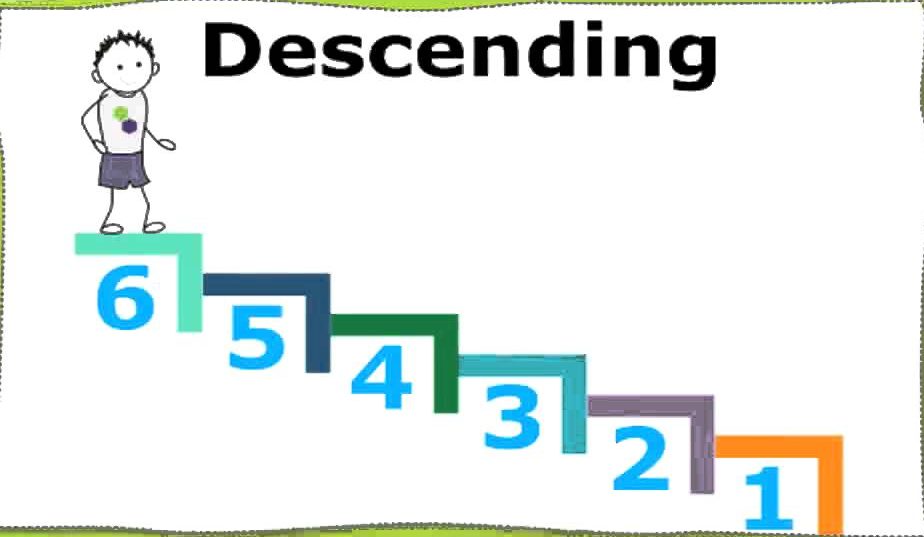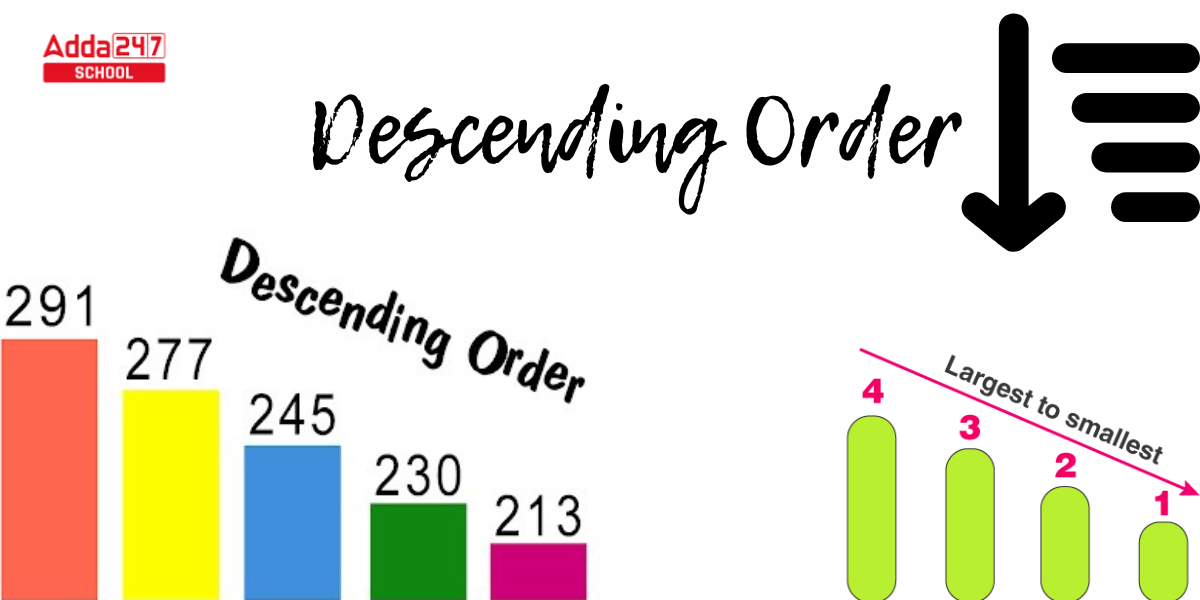Descending Order: In simpler terms, descending order is arranging numbers or data from greatest to smallest. This idea is commonly used in fractions, money amounts, decimals, and numbers.
Descending Order
Descending Order: In everyday situations, data organization in a precise order is frequently required for analysis, comparisons, and efficient processing. Descending Order is one such arrangement in which integers are sorted in decreasing order. In this post, we will explain the Descending Order idea using examples and pictures to provide a thorough grasp.
What is the Meaning of Descending Order?
Descending order indicates that the largest or last item in the list will be at the head of the list. We can also arrange any quantity, decimal, real number, fraction, or whole number in ascending or decreasing order. When it comes to numbers or amounts, the order is largest to smallest. Higher numbers or sums will appear first on the list. For dates, the sort will be from most recent to oldest/earliest. The most recent/latest dates will be listed first. Letters/words are sorted alphabetically from Z to A. For data that contains both numbers and letters/words, such as address lines, the sort is most likely alphanumeric, which means Z to A is sorted first, then 9-0.
Descending Order Examples
A series of numbers arranged from the largest to the smallest is referred to as a “descending order” pattern. This signifies that each number in the sequence is smaller than the one before it, and the sequence decreases from left to right. Descending order refers to the arranging of information (such as numbers, quantities, lengths, and so on) from the largest to the smallest value. Without a few examples, it can be difficult to grasp the concept of descending order. We’ve provided some below, including some word problems, to make things clearer.
Example 1 – In class 5, there are six students. The teacher administered a 20-point test. The teacher should arrange the test results in descending order. The test results are as follows: 11, 7, 13, 9, 15, 12.
The test results are as follows, in descending order: 15, 13, 12, 11, 9, 7.
Because 15 is the highest test score and the greatest number, it is displayed on the left. Because 7 is the lowest test result and smallest number, it is placed on the right. The remaining numbers are ordered in ascending order from largest to smallest.
Example 2 – The descending sequence is explained using a staircase example here. There are six steps in all, with the sixth being the highest and the first being the lowest the boy begins his walk from the highest step and moves towards the lowest. The diagram below can help to better illustrate the concept of ordering.

Descending Order Facts/ Rule
There are some fundamental principles or facts to arrange any data in decreasing order.
- Ascending order is the inverse of descending order.
- The arranging of quantities from the lowest to the highest value is known as ascending order or decreasing order. As a result, it is the inverse process of decreasing order.
- In the example below, we kept removing one from each integer to generate the descending sequence. The situation is not the same in other examples. The order isn’t adhered to in the same way every time.
11→ 10→ 9→ 8→ 7→ 6→ 5
- Always choose the highest number first.
- Make sure you’re arranging them from largest to smallest.
- Your sequence must conclude with the least number from the supplied range.
Descending Order Symbols
We utilize bigger to smaller signs to express descending order, alternatively we can say it as greater than sign – ‘>’. It displays the supplied sequence in ascending to descending order. We shall show the sequence for arranging descending order in math for the ten numbers as 15 > 13 > 9> 8> 5 > 4 > 3 > 2 .
Alphabets in Descending Order
We all know that descending order means going from largest to smallest. We are already familiar with the arranging of integers in decreasing order. We always regard A to be the smallest and Z to be the largest of the alphabets A to Z. As a result, the sequence for decreasing order will begin with Z and end with A. The English Alphabets in descending order is displayed in as follows –
Z> Y> X> W> V> U> T> S> R> Q> P> O> N> M> L> K> J> I> H> G> F> E> D> C> B> A
Descending Order in Decimal
Decimals are ordered in descending order by analyzing the digits from left to right based on their place value. To arrange the decimals in descending order, examine the position of the digits from left to right, from highest place value to lowest.
- First, we look at the total number. If the digits in the whole number component of two or more numbers are the same.
- The digit at the tenth place of the number (i.e., the first digit to the right of the decimal point) is next examined.
- If the digit in the tenths place is the same, we move on to the digit in the hundredths place, and so on.
- This is how decimals are arranged in descending or decreasing order.
Example 1 – 5.3 > 4.67 > 3.45 > 1.41 > 1.07 > 0.99 shows how decimal values are arranged in descending order.
Example 2 – In descending order, 1.70, 2.7, 0.6, 1.45, and 4.95 can be written as 4.95 > 2.7 > 1.70 > 1.45 > 0.6
Descending Order Fraction
- Descending fractions are those that are arranged in decreasing order from greatest to smallest.
example, the fractions 1/2, 3/4, and 1/3 would be arranged in descending order as 3/4 > 1/2 > 1/3.
- Like fractions are a group of two or more fractions that have the same denominator. Alternatively, similar fractions are those that have the same integers in their denominators.
Example – 5/7, 2/7, and 3/7 are fractions and can be placed in descending order as 5/7, 3/7, and 2/7. because their numerators are expressed in ascending order as 5>3>2.
- Unlike fractions are fractions with various denominators rather than the same denominator. To arrange unlike fractions in descending order, convert them to like fractions and compare their numerators.
- When all fractions have the same denominator, the fraction with the largest numerator is regarded as the highest, and the fraction with the smallest numerator is considered the lowest.
Example – 2/3, 4/9, 3/6, and 9/12 are unlike fractions. To begin, take the LCM of their denominators and turn them into similar fractions. 72 is the LCM of 3, 9, 6, and 12.
As a result of matching the denominators, these fractions become 48/72, 32/72, 36/72, 54/72. and after arranging them in descending order they become 54/72, 48/72, 32/72, 36/72.
Descending Order Dates
To arrange number in descending order, we were write them from 10 to 1(backwards). arrangements of descending order of dates is much similar.
- When putting items in chronological order, dates are organised from the most current and most recent one to the oldest one.
- For exam if we arrange – June 4, 2000, January 6, 2008, November 26, 2019, May 1, 2010, August 13, 2022, these 5 dates in descending order. We must check the years first, then the months, and finally the days to arrange the dates in descending order.
- Based on this, we list the dates in the following order – August 13, 2022, November 26, 2019, May 1, 2010, January 6, 2008, and June 4, 2000 .









 CBSE Admit Card 2026 for Private & R...
CBSE Admit Card 2026 for Private & R...
 AILET 2026 AIR 1: Check Full Toppers Lis...
AILET 2026 AIR 1: Check Full Toppers Lis...
 AILET Result 2026 OUT, How to Download S...
AILET Result 2026 OUT, How to Download S...














